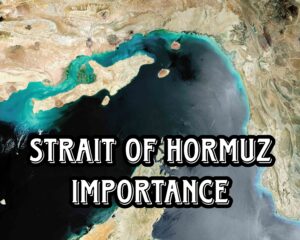
Strait of Hormuz Importance
What is the Strait of Hormuz
The importance of the Strait of Hormuz stems from its strategic location as a key route for transporting oil and other petroleum products from the Middle East to the rest of the world. It is estimated that around 20% of the world’s oil supply passes through the Strait of Hormuz, making it a vital artery for global energy supplies.
The strait is also a politically sensitive area, as it is located near several countries with complex geopolitical relationships. Iran, in particular, has threatened to close the Strait of Hormuz in response to economic sanctions or military actions were taken against it. This has led to tensions and concerns about the potential impact on global oil markets and the world economy.

Importance of the Strait of Hormuz
Oil transport: The Strait of Hormuz is the world’s most important chokepoint for oil transport, accounting for about one-third of the global seaborne oil trade. Almost all of the oil from the Middle East, including Saudi Arabia, Iran, Iraq, Kuwait, Qatar, and the United Arab Emirates, must pass through the Strait of Hormuz to reach global markets. Any disruption to oil flows through the Strait of Hormuz, whether due to conflict, political tensions, or piracy, could lead to a significant increase in oil prices and have a major impact on the global economy.
Natural gas transport: In addition to oil, the Strait of Hormuz is also an important transit point for natural gas. Qatar, the world’s largest exporter of liquefied natural gas (LNG), sends most of its LNG through the strait, and other countries in the region are also significant gas producers.
Geopolitical tensions: The Strait of Hormuz is located near several countries with complex geopolitical relationships. Iran, in particular, has threatened to close the strait in response to economic sanctions or military actions being taken against it. The potential for conflict or disruption in the region has significant implications for global energy markets and security.
Maritime trade: The Strait of Hormuz is a key route for maritime trade between Asia, Europe, and Africa. It connects the Persian Gulf, the Indian Ocean, and the Mediterranean Sea, and is a crucial transit point for container ships, bulk carriers, and other types of vessels.
Military presence: The Strait of Hormuz is also important for military reasons, as it is located near several countries with significant military assets. The United States and other countries have maintained a naval presence in the region to ensure the free flow of oil and other resources through the strait, as well as to deter potential threats from Iran or other regional powers.
Overall, the Strait of Hormuz plays a critical role in the global economy and energy security, and any disruption to the flow of goods or resources through the strait could have significant consequences for countries around the world.
Admin at The Pakistan Gazette

